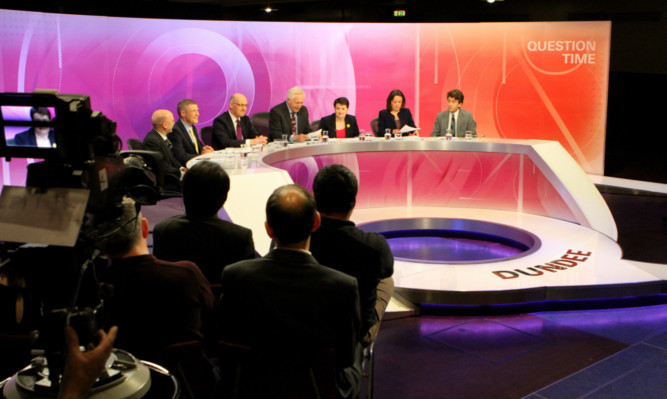Something extraordinary happened in Dundee last week. Yes, it was the BBC’s Question Time, broadcast from the city on Thursday and the subject of much fury ever since.
But first for the extraordinary bit. John Swinney, Scotland’s Finance Minister and a Nationalist, did not get an unequivocally warm reception from the local audience.
In fact, there was hostility detected in some of the questions and at one point when he tried to defend his economic credibility there was even heckling. A senior Nat ridiculed in one of the party’s heartlands? Unheard of.
To an outside observer this might have seemed like the normal political scrap that is the programme’s stock in trade.
The line-up which included the Scottish Conservative leader Ruth Davidson, the Lib Dems’ Willie Rennie, Labour MSP Jenny Marra, the Greens’ Patrick Harvie and the Daily Telegraph’s Timothy Stanley represented all the main parties, a minor one and a wild card, in this case a journalist.
Lively debate
The subject matter was topical, the panellists pugilistic and the debate lively. If it had been, say, George Osborne rather than Swinney waxing lyrical about the state of the nation’s finances he too would have come in for some flak. Such is the nature of political debate.
But this is Scotland and currently we live in a climate so dominated by the SNP and their apologists that any criticism, however valid, is greeted with outrage.
The fact that the city of Dundee was very much in the Yes camp during the independence referendum and that its Holyrood and Westminster seats are currently held by SNP politicians, makes it, in the minds of separatists, a one-party enclave.
But while 57% of the city voted Yes back in 2014, some 43% were Unionists and the Yessers made up just 45% of Dundee’s electorate.
That would suggest there remain many Dundonians possibly even a majority, though I know that’s a heresy who do not support the SNP.
At the very least, there is a sizeable minority who are committed No voters and hold strong views, no doubt, about how the SNP is handling the public purse.
When it emerged last week, days before Question Time was filmed, that Scotland had a £15 billion black hole after nine years of SNP rule, it was not only the Nationalists’ opponents who were alarmed.
There must have been a lot of voters who were broadly in favour of secession 18 months ago but who are now deeply concerned about how Scotland could ever fend for itself.
It is quite understandable that, against this background, answers were demanded of the man most responsible for getting the sums so spectacularly wrong Swinney and that his explanation might not be met with universal approval.
However, Nationalists do not like to be challenged, especially when they know they are on the back foot.
First they accused the BBC of being biased and of inviting an audience that didn’t reflect the pro-Yes sentiment of the city, although the programme makers are duty bound to be impartial.
The BBC expects to be blamed whenever the Nationalists get unfavourable coverage. If the party could, it would seize control of the airwaves and in fact it is trying to, by taking over the national news bulletin and replacing it with Scottish identity programming, much to the viewing public’s horror.
Alien?
Far more chilling, though, have been the attempts by the wider independence movement to disparage the audience as somehow alien because there weren’t enough Dundee accents.
This is not just the lunatic fringe of cybernats anonymously venting spleen as per usual. Nationalist MPs and independence-supporting authors and commentators have also jumped on to this xenophobic bandwagon.
Imagine a Question Time filmed in London and the audience, made up of a multiracial cross section of that city’s community, being attacked for a lack of English accents. What is the difference between such a scenario and the one in Dundee? Is it that Dundonians are supposed to be such a homogenous, ethnically and politically, demographic that anyone who diverges from the separatist consensus must be an outsider?
It is a despicable position to take, especially from a party that professes to be in favour of more immigration. Who would want to come here?
The Nationalists who made such remarks and there are many of them of course deny they are racist or anti-English but they should try to look at themselves in a clear light.
Britain is renowned for its tolerance and the tendency of its ordinary citizens, whatever their politics, to accept people from diverse backgrounds. This is so far removed from the kind of country the Nationalists have dreamed up where people’s politics must be preordained by their accents it is no wonder the Yes dystopia was rejected in 2014.
